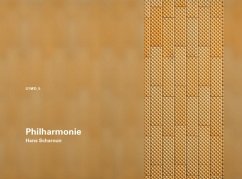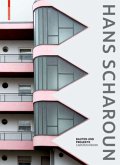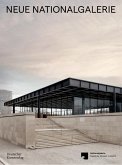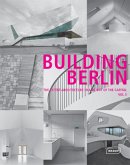Rising with its golden roof from the self-inflicted ashes of World War II, right at the center of the remains of Hitler's megalomaniac World Capital Germania, the new concert hall for the Berlin Philharmonic Orchestra has become the symbol of another Germany; a newly democratized nation that sought to reshape itself with the help of cultural experiences. Today, the Philharmonie is the nucleus of Berlin's Kulturforum with five museums, two concert venues and the state library, West Berlin's response during the Cold War to the Museum Island on the east of Berlin.
Hans Scharoun's design for the Philharmonie is without precedent. It became the paradigm for numerous concert halls all over the world, but none has ever come close to the Philharmonie's conceptual, compositional, constructional, social and synesthetic experiential integrity.
Scharoun (1893-1972) had pursued all his life to project a symbol for new democracy in Germany. Ever since the revolutionary air swept German society after World War I, Scharoun and a number of his friends were dreaming of the new gleaming glass dome on top of a cultural building that would become the alternative to the cathedral. More than four decades later, the purpose-built concert hall for one of the world's most respected orchestras, opened its doors to an avid audience.
The Philharmonie's unconventional forms, mostly non-orthogonal planes with a few curves notably as part of the roof and the ceiling met with incredulity and outright rejection. When the designs were published, vociferous commentators were sure that it could not be built. Its apparent irregularity was thought by some to be costly and unnecessary.
Yet on completion, the spatial magic and the constructional logic won over most critics. Nevertheless, there are some who remain hostile to the design, considering it to be irrational and overly expressive.
With the possibility of publishing the drawings from the Scharoun Archive at the Academy of the Arts, Berlin, anyone with a slightest ability to read drawings will be able to trace the direct approach to the detailing and construction of the Philharmonie's spatially complex, yet highly logical composition.
With this fifth O'Neil Ford Monograph, the Archive of the Academy of the Arts, Berlin, the Center for American Architecture and Design together with the O'Neil Ford Chair in Architecture at the University of Texas at Austin document another outstanding example of contemporary architecture. This fifth volume includes three essays and the reproduction of extensive hitherto unpublished archival material, and concludes with a comprehensive selection of photographs.
Hinweis: Dieser Artikel kann nur an eine deutsche Lieferadresse ausgeliefert werden.
Hans Scharoun's design for the Philharmonie is without precedent. It became the paradigm for numerous concert halls all over the world, but none has ever come close to the Philharmonie's conceptual, compositional, constructional, social and synesthetic experiential integrity.
Scharoun (1893-1972) had pursued all his life to project a symbol for new democracy in Germany. Ever since the revolutionary air swept German society after World War I, Scharoun and a number of his friends were dreaming of the new gleaming glass dome on top of a cultural building that would become the alternative to the cathedral. More than four decades later, the purpose-built concert hall for one of the world's most respected orchestras, opened its doors to an avid audience.
The Philharmonie's unconventional forms, mostly non-orthogonal planes with a few curves notably as part of the roof and the ceiling met with incredulity and outright rejection. When the designs were published, vociferous commentators were sure that it could not be built. Its apparent irregularity was thought by some to be costly and unnecessary.
Yet on completion, the spatial magic and the constructional logic won over most critics. Nevertheless, there are some who remain hostile to the design, considering it to be irrational and overly expressive.
With the possibility of publishing the drawings from the Scharoun Archive at the Academy of the Arts, Berlin, anyone with a slightest ability to read drawings will be able to trace the direct approach to the detailing and construction of the Philharmonie's spatially complex, yet highly logical composition.
With this fifth O'Neil Ford Monograph, the Archive of the Academy of the Arts, Berlin, the Center for American Architecture and Design together with the O'Neil Ford Chair in Architecture at the University of Texas at Austin document another outstanding example of contemporary architecture. This fifth volume includes three essays and the reproduction of extensive hitherto unpublished archival material, and concludes with a comprehensive selection of photographs.
Hinweis: Dieser Artikel kann nur an eine deutsche Lieferadresse ausgeliefert werden.








